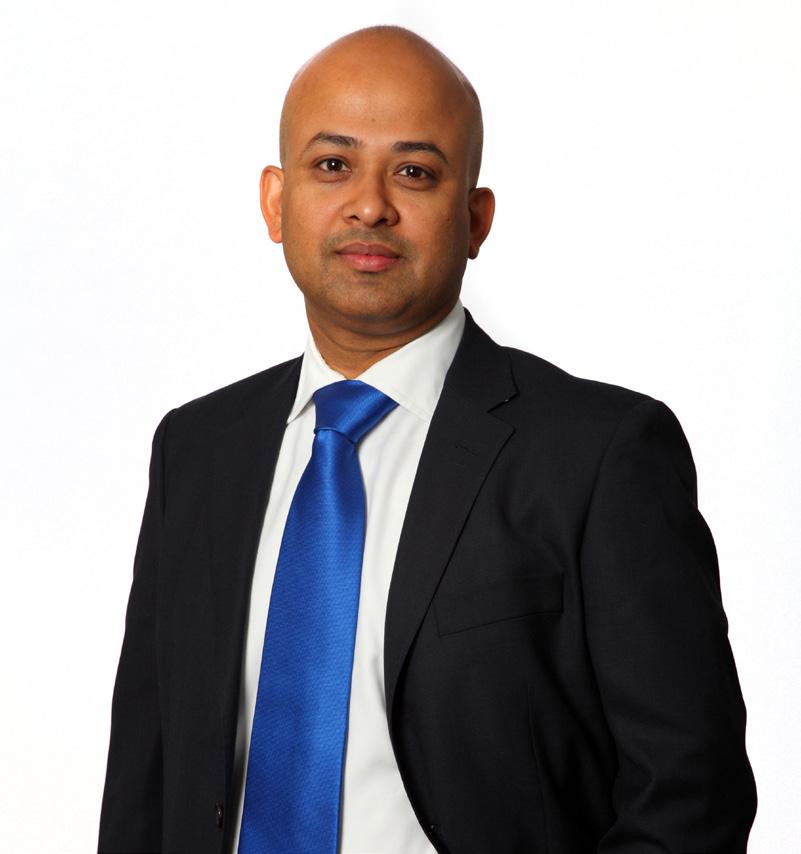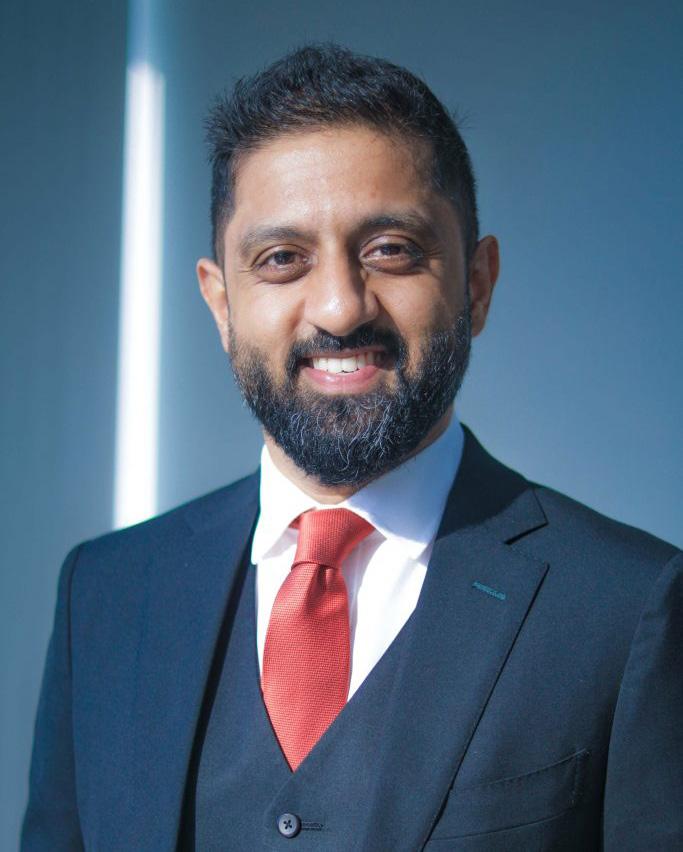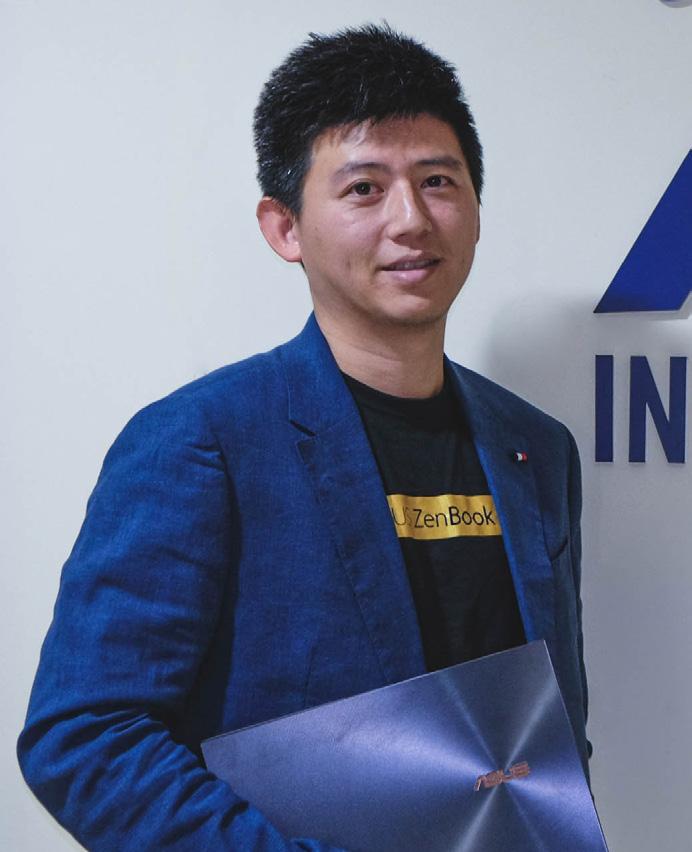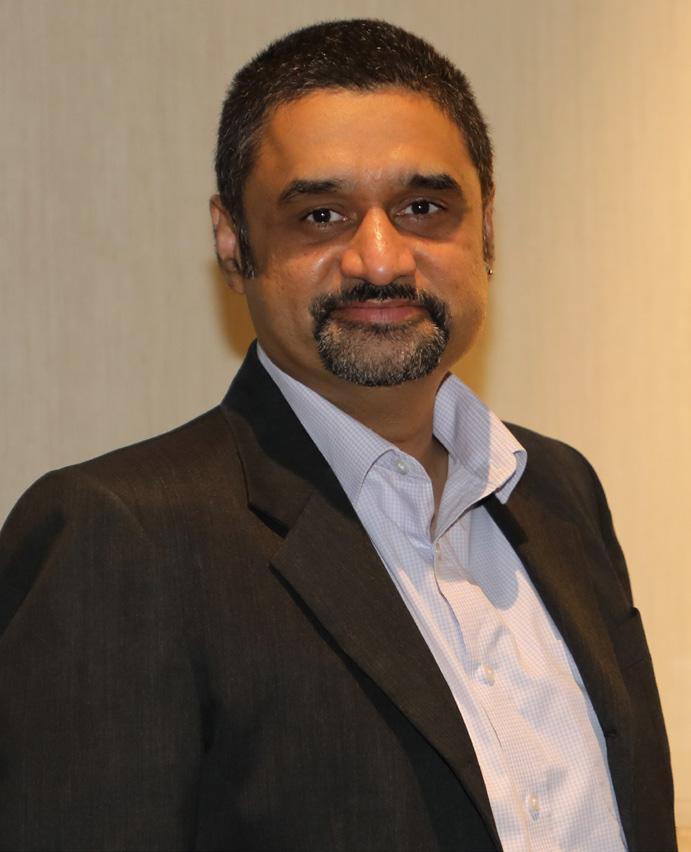
29 minute read
Toshiba Gulf Signs Up Redington
Ingram Micro Launches Cyber Security Self-Assessment Tool CyberGram
Ingram Micro has announced the launch of CyberGram, a Cyber Security self-assessment tool, developed in-house by Ingram Micro to help generate Cyber Security momentum for Business Partners. CyberGram is a user-friendly online platform providing deep insights into an organization’s Cyber Security posture.
Advertisement
Founded on established Cyber Security frameworks, CyberGramSM provides users with highly tailored recommendations to improve Cyber Security maturity enterprise to help organizations enhance the value proposition of Multi-Vendor Architecture solutions. Dr. Ali Baghdadi, SVP & Chief Executive Ingram Micro META Region; and EMEA Cyber Security commented, “Ingram Micro is committed to continuing to provide the right value support of Cyber Security solutions to business partners across the region using our in-house developed software, as well as Consultants and Solution Architects. Our combined approach, shares to best of our people, our processes, and our technology. Supporting our partners in increasing the business value of Cyber Security solutions for their customers enables our partners to address more new business at a lower investment, and generate innovative leads.”
CyberGram enables users to evaluate their environment across distinct levels of Cyber Security maturity. The tool then provides a detailed report with tailored recommendations designed to strengthen the users’ Cyber Security posture.
Tenable is celebrating a successful year as deepwatch’s preferred risk-based vulnerability management partner. The levels end-to-end across the
strategic partnership combines Tenable’s industry-leading vulnerability management solutions with deepwatch’s innovative cloud SecOps platform and managed services to help joint customers see their systems, predict what matters and act to reduce risk, especially as they prioritize cloud computing.
“Over the past year, we’ve seen a massive, global shift to the cloud and remote workforces,” said Mark Thurmond, chief operating officer, Tenable. “We’re helping customers accelerate their cloud journeys swiftly and securely by combining our industry-leading solutions with deepwatch’s elite team of security experts. Forward-leaning partners such as deepwatch are the bedrock of our channel strategy and we remain deeply committed to working in lockstep with them."

“After rigorous testing and customer feedback, we determined that Tenable is the gold standard and selected them as our preferred vulnerability management partner,” said Charlie Thomas, chief executive officer, deepwatch. “Offering the only risk-based vulnerability management solution that provides a holistic view of the modern enterprise — spanning IT to OT and everything in between — Tenable has been instrumental in the strong growth of our vulnerability and risk management solution which has grown 129% over the last two years. Together, we’re advancing the service of managed security to future-proof customers’ technology investments. We look forward to expanding our strategic partnership well into the future."
Toshiba Gulf Signs Up Redington for Regional Distribution
Toshiba Gulf has appointed regional distributor, Redington Gulf, to handle their memory and storage solutions product portfolio for Oman, Qatar, Bahrain, Kuwait and Saudi Arabia. The distribution partnership was formalised at GITEX 2020 in a signing ceremony. at the forefront and position ourselves as market leaders for storage and memory solutions, we are excited to partner with Redington and are confident that in a short time, our brands will have the market footprint it deserves. We look forward to Redington Gulf’s value added services for our products." enables us to offer a wider choice of storage products to our partners in the region and become their preferred distributor for sourcing storage products. As part of this agreement, Redington will ensure availability of products locally in the countries we are contracted through our robust in-country distribution capabilities and an engaged partner network,” said Jeetendra Berry, President-IT Volume Middle East, Redington Gulf.
Commvault Gets New Vice President for Global Channel and Alliances

Commvault has announced the appointment of John Tavares as Vice President, Global Channel and Alliances. In his new role, Tavares will be responsible for overseeing the growth of Commvault’s Global Partner Organization and strengthening the company’s relationships with partners worldwide. Tavares joins Commvault from Dell EMC, where he worked in a variety of sales leadership roles, first for EMC and continuing through the merger with Dell, for the last 25 years. During his tenure with Dell EMC, Tavares grew the company’s datacentre business encompassing software, hardware, and services, built a world-class sales team, and increased revenue year-over-year.
“I am excited to bring my long-standing sales expertise to Commvault and aid the company in continuing to grow its reputation for providing trusted enterprise-grade data management solutions across the global channel,“ said Tavares. “The Global Partner Organization has done some amazing things, especially during such uncertain times this past year. I look forward to building on this momentum and creating long-lasting partnerships that will truly benefit our customers.”
With this change, Commvault’s former Vice President of the Global Partner Organization, Mercer Rowe, will be taking on the role of Area Vice President for Commvault’s business in Japan. He will be focused on growing Metallic, Commvault’s SaaS division, in the region and further strengthening Commvault’s presence in Asia Pacific.
"John is joining Commvault at the perfect time – bringing his wealth of valuable expertise to the Global Partner Organization and serving as a barometer of what we can expect in this next fiscal year,” said Riccardo Di Blasio, Chief Revenue Officer, at Commvault. “With John as the head of our GPO, working closely with our regional leadership, I am confident that our partnership opportunities will flourish, reaching new audiences and increasing productivity.”
Nutanix Appoints Rajiv Ramaswami as Chief Executive Officer
Nutanix has announced that its Board of Directors has appointed Rajiv Ramaswami as President and Chief Executive Officer, effective Wednesday, December 9, 2020, and as a member of the Board of Directors, effective Monday, December 14, 2020. Ramaswami will succeed co-founder Dheeraj Pandey, who previously announced his plans to retire as CEO of Nutanix upon the appointment of a successor.
Ramaswami is a seasoned technology industry executive who has held senior executive roles at industry leaders including VMware, Broadcom, Cisco, and Nortel, after having begun his career at IBM. Ramaswami has an impressive, 30+ year track record of building and scaling businesses in cloud services, software, and network infrastructure. In his most recent role as Chief Operating Officer, Products and Cloud Services at VMware, Ramaswami co-managed VMware’s portfolio of products and services. During his tenure, Ramaswami led several important acquisitions and was playing a key role in transitioning VMware toward a subscription and SaaS model.
“I’m thrilled to be joining Nutanix at this transformative time for the company and the industry,” said Ramaswami. “I have long admired Nutanix as a formidable competitor, a pioneer in hyperconverged infrastructure solutions and a leader in cloud software. Working closely with the Board, the management team, and the more than 6,000 talented Nutanix employees around the world, we will build on Nutanix’s strong foundation of continuous innovation, collaboration and customer delight. Together, we will capitalize on the significant opportunities ahead and deliver on the company’s next phase of growth and value creation.”
“Rajiv is the right leader at the right time,” said Nutanix Co-founder Dheeraj Pandey. “With a future-proof business model, a loyal and expanding customer base, and a strong technology portfolio, I look forward to seeing Rajiv take the helm to lead this incredible team. This is the decade to watch for a company that so values simple, secure, and seamless. On a personal note, it has been a privilege to serve our customers and partners, working closely alongside Nutanix employees.” Dheeraj Pandey will step down from the Board effective Monday, December 14, 2020, to ensure continuity through Nutanix’s upcoming Annual Meeting of Stockholders.
Before joining Nutanix, Ramaswami served as Chief Operating Officer of Products and Cloud Services at VMware. Prior to this role, Ramaswami led VMware’s Networking and Security business, one of the fastest-growing units in the company, as Executive Vice President and General Manager.
THREE WAYS AN INDOOR CAMERA OFFERS PEACE OF MIND

For those who are currently used to the unique rhythm of working from home (#WFH, as it’s referred to on social media), even the thought of going back to a 9-to-5 routine can be disconcerting. More so if you’re leaving family or pets at home for extended periods of time, after they’d gotten used to having you around all day.
Although some may heave a sigh of relief to have a bit of “me time”, there are several occasions when you may need to check in with what’s going on at home. You may want to see if your kids have gotten home from school on time and have eaten something, whether an older parent has taken their medication, or if your pets aren’t too upset at being left alone.
For many UAE residents, indoor video cameras can help ease the long daily separation. This is 2020, after all, and physical location shouldn’t have to present any limitations to communication and peace of mind. Whether for humans or animals, there are several ways that home video cameras can help ease that separation anxiety for both parties – with a few added benefits.
CHECK IN ON THINGS AT HOME
Consumers around the world have been using Ring Video Doorbells to remotely monitor their homes, to check in on their pets, and even to confirm that their kids got home. That inspired Jamie Siminoff, Ring’s founder, to create a dedicated indoor device that serves these customers.
Ring’s new Indoor Cam is a mini marvel that plugs into the tightest spaces so you can simply check on what’s happening at home from anywhere and at any time – all Heading back to the office after #WFH? An indoor camera can help ease the transition for family and pets alike, says Mohammad Meraj Hoda, Vice President of Business Development – Middle East & Africa at Ring
from your smartphone. Perhaps you want to see if your teenage kids are getting to their homework, or if there’s a stressful event responsible for your cat’s unsettled behavior while you’re away. A quick check is easy with a compact indoor camera.
TALK TO FAMILY AND FLAT MATES
In one of those wonderful technological developments that prove we really do live in the 21st century, the best indoor cameras now come equipped with twoway conversation features, allowing you to connect and communicate with those at home from wherever you are.
With their high-quality audio, Ring’s indoor cameras are just like a video call – only better. By checking the Ring app from your office, your car or anywhere else, you can converse with your kids, the domestic helper, or even your pets! It’s peace of mind for everyone.
GET ALERTED TO UNUSUAL ACTIVITY
Since they can be activated by certain movements, most indoor cameras can alert you to abnormal activity within your home. Market leading products, such as those now available to order from Ring, for example, will instantly send you a phone notification when motion is detected. With a couple of indoor cameras in strategic places – perhaps in the hallway, in the living room, or elsewhere – you’ll immediately be alerted to anything atypical.
So, whether you’ve got to work late to catch up on all those post-coronavirus targets, or if you’re on a site visit to another part of the Emirates, the right indoor camera keeps you calm and in control. Nothing can entirely replace your physical presence, but technology can help you, your family, and even your fur babies to adjust to the back-to-office season more easily.

Human behavior towards cybersecurity practices or today's greatest challenge - managing the risk of the pandemic, varies by individuals. Yet every social action or organizational behavior has a consequence. By monitoring human activity and reinforcing positive actions to adopt safe cybersecurity practices or following safe-pandemic practices, organizations and human communities can benefit.

Designing applications that reward an individual with points and badges and displays them publicly can help mobilize positive movement. Gamifications can help improve the level of compliance towards following basic cybersecurity best practices in an organization, the same way as they can influence communities to shun risky post pandemic behavior. Organizations criticize the lack of availability of technology skills and especially those of cybersecurity expertise. Yet both human resources heads in organizations and information technology heads do not realize that a lot can be achieved in their business by educating and motivating the workforce to adopt best practices of cybersecurity.
Many employees in the workforce can also be inspired to train themselves in cybersecurity skills to manage the basic administration of their devices and networks. With remote workforces becoming part of the post-pandemic workplace there is a human resource requirement to relook at the level of basic technology skills across the hybrid workforce. However, a gamification approach may be required to add an active element of interest around this activity. Here are some basic tips on what administrators can do to kick start a cool and gamified approach towards technology:
PROTECTING REMOTE WORKERS BY ENCOURAGING COOLNESS IN TECHNOLOGY AND CYBERSECURITY
Ned Baltagi, Managing Director, Middle East & Africa at SANS Institute advises organizations that this is the time to add a bit of coolness and fun into technology and help workers become more comfortable with basic cybersecurity and technology best practices.
#1 Personal information across Internet
It is essential that remote workers maintain a clean record on the Internet. The post-pandemic phase has seen a disproportionate level of stress and readjustment and this may continue in the months ahead. But venting strong feelings and thoughts across multiple social media sites may just start working against remote workers and their teams. Threat actors are looking for such displays of personal information including family names, assets and other information, shared under duress, that can be used in phishing attacks.
#2 Break and fix technology and devices
One of the fastest ways for remote workers to get comfortable and experienced is to allow them to build up software tools and use them to test the technologies at their remote workplace. Instruct remote workers how to spend hands-on time with technology, engage with technology, break it and then fix-it. There are a lot of amazing free tools and resources available online for remote teams to work and play with. Some are more easier to use than the other, and you do have to make sure you know where to find them. But open source tools are a great way of expanding your tool kit and skill set.
#3 Build the technology lab at home
If remote workers are at home let them feel comfortable to build a lab at home. Encourage teams to be curious about technology, allowing them to make mistakes. The more mistakes they make, the more they are learning. And more technology learning helps to boost better understanding of cyber security best practices. #4 Share technology experiences. Get remote workers and teams to share their experiences. If you want to physically protect a building, you need to understand doors, windows, and structure. For information security, remote workers need to understand the basics of computer networking. Understanding how computers function and communicate is the first step in defending them from cyberattacks.
#5 Finding a mentor
An experienced worker who is ready to engage with remote teams, can boost the confidence levels of remote workers who may find themselves without support at odd hours of the day or night. With remote workers dispersed across the country and the globe, while working under the same work deadlines as they would in conventional offices, lack of face to face access to co-workers is often a huge demotivation. Informal mentorship can help plug such gaps and help to retain confidence in the organization's technology set up across remote workers and remote teams. On a final note, every remote worker has their favorite device, app or feature. Use that as a starting point for them to explore, learn, share and move forward. Conforming to and understanding the organization's cybersecurity best practices may just become an easy ride for them as they plunge into technologies that help them to work better and better.
#6 Expand your skillset with CTFs and Ranges
Capture the Flag events are not only a great way to interact with your peers and like-minded individuals, they are also a great way to learn and apply new skills in a real-life situation. Playing either on your own or with your team and really help you hone your skills.
ORCHESTRATION AND THREAT INTELLIGENCE - ENGINE AND FUEL

Written by Anthony Perridge, VP of International at ThreatQuotient
These days we believe that “it’s not a matter of if, but when and how” we’ll be attacked. So, we’ve expanded our focus from prevention to include detection and response, and organizations are talking about using Security Orchestration, Automation and Response (SOAR) tools.
According to Gartner’s Market Guide for Security Orchestration, Automation and Response (SOAR) Solutions, by yearend 2022, 30% of organizations with a security team larger than five people will leverage SOAR tools in their security operations, up from less than 5% in 2019. There are many factors driving demand, chief among them the shortage of skilled cybersecurity talent which is compelling most organizations to look for ways to automate routine, repeatable tasks.
Orchestration tools, specifically playbooks, are good for automating processes that we know we always perform the same way. The system responds reflexively, thus reducing the need for humans in this capacity. Playbooks help Incident Response (IR) teams accelerate response and mitigate risk, while freeing up expert resources to focus on higher value tasks which also helps with employee retention.
An organization’s Threat Intelligence practice has a different role – gathering external and internal threat and event data, normalizing it for analysis, and automatically scoring and prioritizing it based on organization-specific parameters. With a platform that serves as a central repository and organizational memory, teams and tools have access to the organization’s history of investigations, observations and learnings about adversaries and their tactics, techniques and procedures (TTPs). Adding new data and learnings over time, the platform automatically reevaluates and reprioritizes intelligence to support ongoing detection, investigation and response.
Both orchestration tools and a threat intelligence platform serve the same high-level goal: Optimize people’s time so they can focus on areas where their intelligence, experience and skills are needed, and don’t waste time on things that can be easily automated. What makes these tools even stronger is when they work together.
The fact is, there is more we can do to optimize playbooks so that they save exponentially more time. When driven by threat intelligence, an orchestration tool can recognize connections and patterns, and adjust playbook runs to maximize efficiency. And when a threat intelligence platform brings in learnings from the IR practice, it can augment and enrich threat intelligence with greater context to further accelerate detection and response.
Using a phishing campaign as an example, let’s say that the organization has been targeted with 100 emails. The playbook flags something unknown, forwards it to a tool for inspection which confirms it is suspicious, then sends it to a sandbox that validates it is malware. The file is then added to the reputation block list. When the next suspicious email comes in, the playbook repeats the same process. Over time the reputation list gets longer and longer, and system performance gets slower and slower responding repeatedly to the same requests.
But if the orchestration tool works in concert with the threat intelligence solution, then the full playbook does not need to be executed each time. The threat intelligence platform remembers activity from the same malware family and campaign and recognizes that it is an immediate and actual threat to the organization and scores it accordingly at a 9 or 10. The playbook can be written to adjust processes based on scoring so, for example, a score of 7-10 may trigger automatic blocking. A score of 3 to 7 may send the file directly to the sandbox. Anything lower initiates the full playbook. The ability for playbooks to dynamically adjust based on scoring increases the efficiency of tools and teams.
Another aspect that improves when orchestration and threat intelligence work together, is reputation list management. It isn’t the job of the orchestration tool to curate the reputation list which can become unwieldy very quickly. However, a threat intelligence platform tracks and stores threat and event data from all sources and groups and remembers what it has seen, which allows it to understand the lifecycle of the threat and when to cull the reputation list. Because information that is no longer relevant is removed, new information can be added without the risk of overloading the reputation list.
The orchestration tool is about working the reflex, while the threat intelligence practice is about working the memory. Although their approaches are different, orchestration tools and threat intelligence platforms share the same goal: to accelerate detection, response and risk mitigation. And when they work together, they save teams more time and deliver even better results.
Antoine Harb, Team Leader Middle East, and North Africa at Kingston Technology, speaks about the learnings from 2020 and his plans for 2021
How was 2020 for the industry and your company?
Working from home was a big hurdle for all Industries. As millions of professionals adjust to the new normal of working remotely, staff and supervisors have had to learn quickly how to improve communication and collaboration in a virtual setting.
IT Departments had to overhaul strategies overnight to allow working from home, followed by education on security to ensure that data remains safe. This naturally led to an increased number of people gaining a better understanding of their own technology followed by a greater personal interest in reliability, speed, and safety. Kingston is able to play a part in this by helping with that education.
What sort of opportunities did 2020 bring along?
As near to everyone, across all industries had to adjust to Working- From-Home (WFH) we noted an increased interest in the education of employees on topics such as Cyber Security and how to keep data safe when it is leaving the office/work premises.
Next to this accelerated educational interest, Kingston Technology has experienced an increase in the demand for Laptop DRAM and SSD’s, as both adults and children had to adapt to the new normal of working from home and homeschooling.
We further noticed a higher E-tailer demand, due to the movement restrictions and lockdown. As a result of larger numbers of people spending most of their time at home, we also saw an increased demand for our gaming products, such as the HyperX DRAM and NVMe SSD’s.
What were your key achievements in 2020?
At Kingston Technology we were able to adapt quickly to the situation and to maintain a high level of services and support to Kingston ’ s partners and customers. Our wide product range further enabled Kingston to find its stronghold in the new demand for WFH equipment including DRAM products or the increased demand for SSD.
More important though is the support and education Kingston Technology is offering to ensure that not only the equipment is available, but our customers are thinking about their data security.
What promises does 2021 bring along?
First of all, we hope for it to bring more normalcy, certainty, and safety for everyone. We further believe, that working from home will continue after the pandemic as we can already see, that employees are actively requesting WFH to be part of their new jobs and companies can see the efficiency gained from reducing commuting time.
Due to this change and fewer investments in commutes and business travel, Analysts such as Gartner are predicting, that the worldwide IT budgets are going to grow by 4% in 2021. These are obviously very promising predictions for most technology companies but next to equipping our customers with the top of the range technology solutions, Kingston especially wants to raise awareness about data security and how encrypted solutions can help with it.
Do you see opportunities in the regional markets with new markets opening up?
Yes, we have already experienced a big growth of E-tailer ’ s and we believe that more opportunities will come as many people are getting more dependent and familiar with online shopping.
This will also have a long-term effect on stores and resellers as they are in need of fully developed online shops in order to survive this difficult time.
According to you, which technologies will be in demand in 2021?
With WFH probably still being a big part of our life for a while as businesses are rethinking their office set-ups and many potentially downsizing their office space and introducing part time WFH as part of their long-term solution, we expect to see healthy demand for SSD, DRAM, and encrypted devices.

The lasting transition from city center offices to a hybrid solution of WFH and days in the office also comes with an even greater need for connectivity. Never has the need for a quicker further spread connectivity solutions such as 5G been higher. This potential acceleration of 5G will also require a great need for data centers.
What will be your key focus areas for 2021?
We will address two focus areas in 2021. Firstly, Kingston Technology will be addressing the demand for higher capacities SSDs coupled with the demand for higher performance drives. There will also be a strong focus on the demand for DRAM in both the consumer and B to B markets and particularly the Data Center space.
What milestones have you set for 2021?
Our goals for 2021 are to maintain our focus, build product awareness use sales momentum and to support and stay close to our strategic customers, while at the same time raising awareness on Data Security and encrypted devices.
What would you like to do differently in 2021, when compared with 2020?
2020 was a difficult year for most industries and individuals. For us at Kingston, it is our priority to stay close to our partners and customers and hope that we might be lucky enough to be re-scheduling face to face meetings in 2021.
Avinash Advani, the Founder, and CEO of CyberKnight, speaks about what worked for his company in 2020 and what he expects from the upcoming year

How was 2020 for the industry and your company?
2020 was a shock to both the industry, as well as, CyberKnight. The industry was rattled in H1 as orders slowed drastically and budgets were put on hold, but then there was light at the end of the tunnel as we started to emerge from the lockdown in H2, with exponential funnel growth, a steady increase in orders, and budgets being reprovisioned, albeit with a focus on doing more with less.
As a start-up having launched operations shortly before the pandemic hit, we were definitely caught off guard when our ability to execute on our year-one plans suddenly ground to a halt after only a quarter. That being said, we made the most of working from home in Q2 and conducted focused online campaigns to help customers understand the risks associated with remote working, as well as, the importance of Zero Trust.
In H2, we went back to the office, although most meetings were virtual, and we did our very best to make up for the previous quarter by maximizing pipeline creation, aligning closely with our strategic partners, and helping evangelize Zero Trust Security as advisors to enterprise and government organizations across the Middle East.
What sort of opportunities did 2020 bring along?
Although some countries have had workfrom-home cultures for some time, 2020 taught us that remote working will be part of the new normal, globally. This creates efficiencies for some companies that can reduce their office space overhead and its associated costs, but this digital transformation has created new complex IT environments that in turn come with security gaps that need to be bridged with intelligent security.
As we saw over the course of the pandemic, cyber attackers continued their onslaught and therefore it is critical for organizations to think about Zero Trust Security. The traditional perimeter is vanishing, remote and mobile users are the norm, and the cloud is everywhere, so security needs to follow the data, users, and applications, no matter where they are located.
What were your key achievements in 2020?
CyberKnight’s official launch was in January 2020. The months that ensued saw the onboarding of 23 market-leading cybersecurity vendors mapped to the Zero Trust Security framework. We were able to deploy local teams across all key Middle East markets, with our headquarters in Dubai and a local office in Riyadh, enabling local invoicing in Saudi Arabia as well. We transacted more than 60 strategic partners across the region, who in turn have sold one or more of our technologies to more than 100 end-users.
What promises does 2021 bring along?
It will take time for companies to transition from conservativeness to optimism, and this may be reflected in slower hiring and expansion, as well as, more cautious target-setting, as companies make the most out of existing investments.
We are hoping that the vaccine will be effective and the world will reach herd immunity as soon as possible so that Coronavirus times can be put behind us. From a company perspective, our theme for 2021 will be “The Year of Stabilization”, which means letting the dust settle, bringing certainty to business operations, and confidence to achieving business goals.
Do you see opportunities in the regional markets with new markets opening up?
2021 will see our continued focus on the Middle East and Africa region. We see significant potential in Egypt as a new market ripe for on-the-ground investments.
According to you, which technologies will be in demand in 2021?
From a cybersecurity perspective: • XDR and AI-based prevention technologies that protect against ransomware and nation-state attacks will be board-level priorities Cloud Security Remote Workforce Security IT/OT Security Convergence
What will be your key focus areas for 2021?
We are 100% cybersecurity-focused and have built our offering around Zero Trust Security. In 2020 we launched our Unified Threat Intelligence campaign, and in 2021 we will be looking at a new story encompassing SecOps and Threat Hunting.
What milestones have you set for 2021?
As the market hopefully returns to some semblance of normalcy, we will be looking to double revenue, achieve higher profitability through value-add business, and optimize processes.
What would you like to do differently in 2021, when compared with 2020?
My hope is that face-to-face end-user meetings resume so that we can once again meet our strategic customers in-person.
Do you plan to enter new markets or add new products/applications to your portfolio in 2021?
Yes definitely, but the expansion into new markets depends on how quickly the markets return to normal trading conditions. Based on the roll-out of the COVID-19 vaccines, we will be evaluating the addition of local resources in Egypt.
Also, we are always looking at portfolio evolution and enhancement. Therefore, portfolio changes will happen throughout the year as we aim to complete our offering and plug gaps with best-of-breed cybersecurity vendors.
Only With Agility Can Business Perform
Morgan Chen, the Notebook and Gaming Notebook Business Development Manager for UAE and GCC at ASUS Middle East, speaks about the challenges faced in 2020 and his business outlook for 2021

How was 2020 for the industry and your company?
2020 is an unprecedented year for the industry. Consumer behavior, retail sales, and supply chain have been reformed to cater to the influence of pandemic.
What sort of opportunities did 2020 bring along?
In 2020, due to the pandemic, computers regained importance in life and became the essential items in each household by the unique productivity to continue working and learning at home.
Did you face any challenges in 2020?
The current supply chain for an IT product is globalized. The lockdown policies in different countries at different timeframes brought up the challenge of stable and sufficient supply.
What were your key achievements in 2020?
In 2020, with a prescient leadership strategy and the team’s great efforts, ASUS achieved a historically high market share in the UAE. In the same year, we have also launched unprecedently ASUS Perfect Warranty, being the first and the only brand providing users warranty to cover accidental damages under normal use.
What promises does 2021 bring along?
Rapid innovations in different fields, including hardware, software, telecommunication, medicine, and so forth, help human beings to have the same or even better quality of life, work, and education than the pre-pandemic period.
Do you see opportunities in the regional markets with new markets opening up?
Along with lower contacts and interactions, some inconvenience also came to our lives, so the opportunities are everywhere for solutions for improving our lives.
According to you, which technologies will be in demand in 2021?
Remote Collaboration: In 2020, more people than ever before are working or learning from home, so remote-collaboration technology like a virtual meeting, online classroom, project collaboration will be the key to ensure the quality of work and study.
Cybersecurity and Privacy: Under these frequent remote-collaborations, vast business and personal information might be exposed, so how to ensure information security will be essential.
Contactless: Taking precautionary measures to the pandemic, all the direct and indirect contacts are encouraged to minimize, so contactless technology will definitely be a trend for all aspects in life.
What will be your key focus areas for 2021?
Computers for commercial and educational purposes will be our focus areas in 2021. With innovative product design, reliable quality, and supportive after-sales service, we believe that ASUS products can help users to perform at work and study efficiently.
What milestones have you set for 2021?
We expect our products, services, solutions can help more and more users to perform in life and continue being the best laptop brand in the world in 2021.
What would you like to do differently in 2021, when compared with 2020?
Be even more agile to changes. We are continually facing an unprecedented and uncertain year in 2021. Only with agility, a business can perform.
Do you plan to enter new markets or add new products/applications to your portfolio in 2021?
Products, services, and solutions for commercial and education usage will be our major focus fields in 2021.










